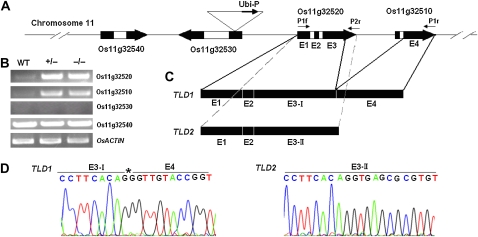Figure 2.
The cloning of TLD1 and TLD2. A, Schematic representation of the T-DNA insertion site on rice chromosome 11. The ubiquitin promoter in the T-DNA was inserted into Os11g32530. White boxes, Introns; black boxes, exons; E1 to E4, the four exons in Os11g32520 and Os11g32510. The primers used for cloning are indicated above the exons. B, RT-PCR analysis of the transcript levels in wild-type (WT), heterozygous tld1-D (+/−), and homozygous tld1-D (−/−) seedlings. OsACTIN was used as an internal control. C, The selective splicing of Os11g32520 and Os11g32510 produces two splice variants: TLD1 and TLD2. The accession number for TLD2 mRNA in the National Center for Biotechnology Information database is NM 001074537. D, Nucleotide sequences of the TLD1 and TLD2 cDNAs. The left panel shows the junction between E3-I and E4 in TLD1. The asterisk indicates the cleavage site at the end of E3 that produces E3-I. The right panel shows the E3 region shown in the left panel without cleavage, which produces E3-II of TLD2.

